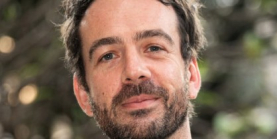
Gabriel Guerrer is a Brazilian experimental physicist who has investigated the possible influence of consciousness on matter.
Career
Gabriel Guerrer holds a doctorate in physics from the Brazilian Centre for Physics Research (CBPF), and has contributed to the LHCb experiment at CERN's particle accelerator. Currently he is a postdoctoral fellow at the D'Or Institute for Research and Education (IDOR), where his multidisciplinary pursuits span information theory, neuroscience and the philosophy of mind. He is exploring anomalistic psychology and metascience, including pioneering open-source tools to fathom human influences on randomness.
By 2015, Dean Radin had carried out experiments suggesting an influence of human consciousness on the interference pattern of a double-slit optical light system. Guerrer had worked on understanding the matter-antimatter asymmetry problem at the CERN LHCb experiment until 2009. Motivated by reading in Radin’s books about his double-slit work, he attempted to replicate it.1 After a successful crowd funding campaign Guerrer began work in 2016. Exploratory-phase testing involving 160 participants was followed by confirmatory testing involving 80 participants.
Double-slit Replication
Guerrer’s work constitutes a comprehensive investigation into consciousness-related interactions with a double-slit system. Initially his exploratory experiments highlighted disparities between intention and relax conditions. After this exploratory phase, which identified the most compelling set of analysis parameters, a confirmatory experiment was conducted, yielding non-significant results. A post hoc analysis exposed a need for further studies and clarification.2
Noise-based Random Number Generator
In a recently published article, Guerrer describes the design of a random number generator (RNG) called RAVA that is based on two random sources. RAVA, an open-source True Random Number Generator (TNRG) utilizes reverse-biased Zener diodes for producing random outputs. Guerrer ran several statistical analyses, including NIST randomness tests and comparisons with a Quantis device, in order to validate the randomness and reliability of RAVA's output. The study explored environmental influences, demonstrating the circuit's resilience to factors like temperature variations. Guerrer emphasizes the device’s high throughput of 136.0 Kbit/s, suitable for diverse applications such as personal privacy, research, education, arts, and the maker community. RAVA's open-source nature promotes transparency and customizability, allowing users to explore the circuit's intricacies and contribute to ongoing community-based development. Guerrer concludes the article by presenting a vision for RAVA to evolve into a standard and trusted RNG through collaborative improvement and adherence to open-source principles.3
Experiment
In research presented at the 2025 Science of Consciousness conference in Barcelona, Guerrer and co-workers investigated whether conscious intention can influence distant random number generators through four preregistered experiments. Participants attempted to mentally affect remote devices while observing real-time feedback via videoconference, with 480 total sessions including controls. Results showed no evidence supporting anomalous mind-matter interactions, with no experiments meeting success criteria. The research demonstrates enhanced methodological standards for investigating unconventional phenomena through rigorous preregistration and replication protocols.4
Michael Duggan
Literature
Guerrer, G. (2019). Consciousness-related interactions in a double-slit optical system Accessed Google Scholar, (25th December, 2023).
Guerrer, G. (2023). RAVA: An Open Hardware True Random Number Generator Based on Avalanche Noise. IEEE Access, 11, 119568-119583.
Guerrer, G., Walleczek, J., Stillfried, v.N., Kffuri, S., Moll, J. (2025). The Case of Anomalous Psycho-Physical Interactions: Investigating an Unconventional Hypothesis Within a Methodologically Rigorous Framework Proceedings of the Science of Consciousness Conference. Barcelona, 7-11 July 2025.
Radin, D. Michel, L., Delorme, A. (2016). Psychophysical modulation of fringe visibility in a distant double-slit optical system. Physics Essays 29/1, 14-22.

